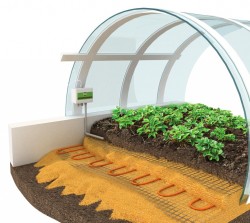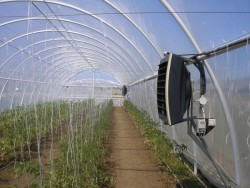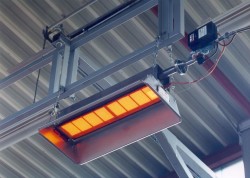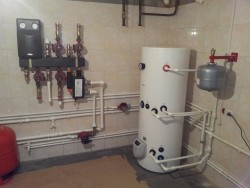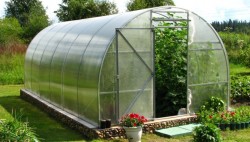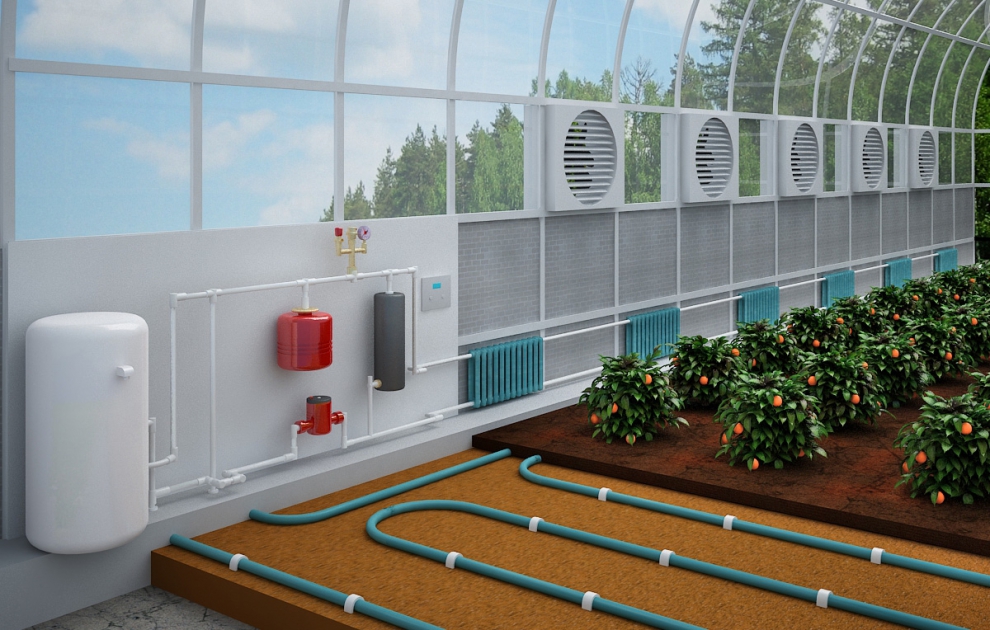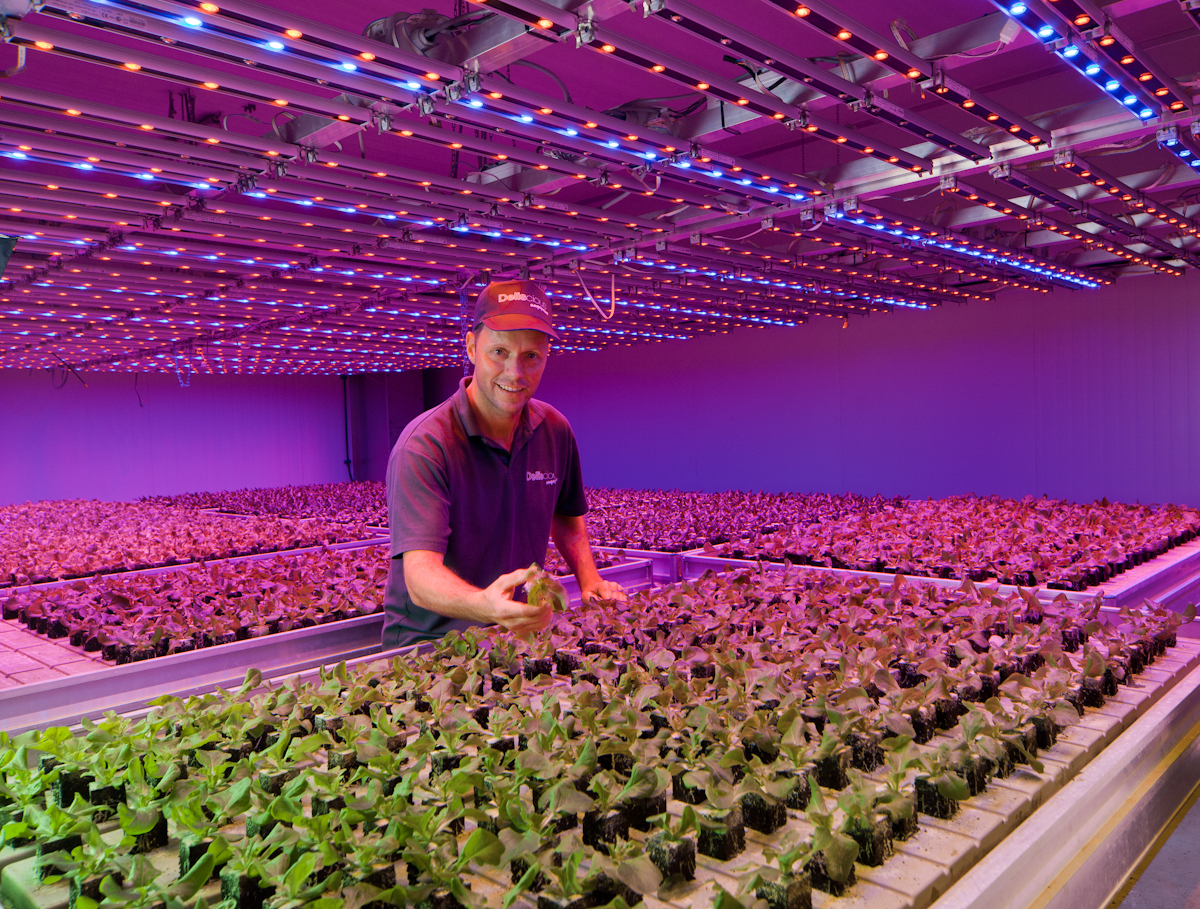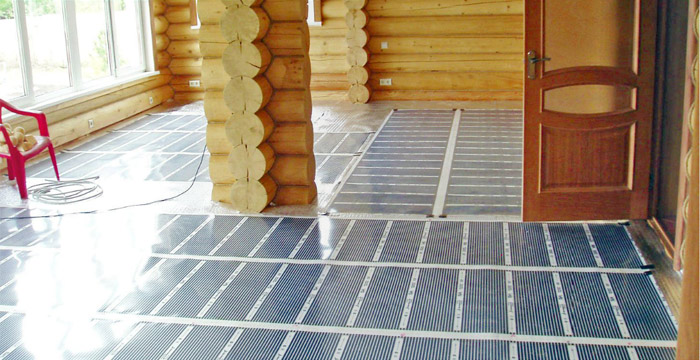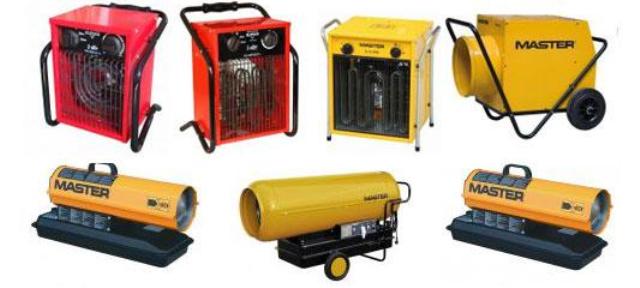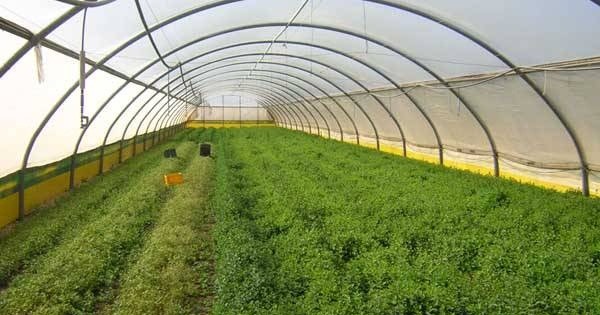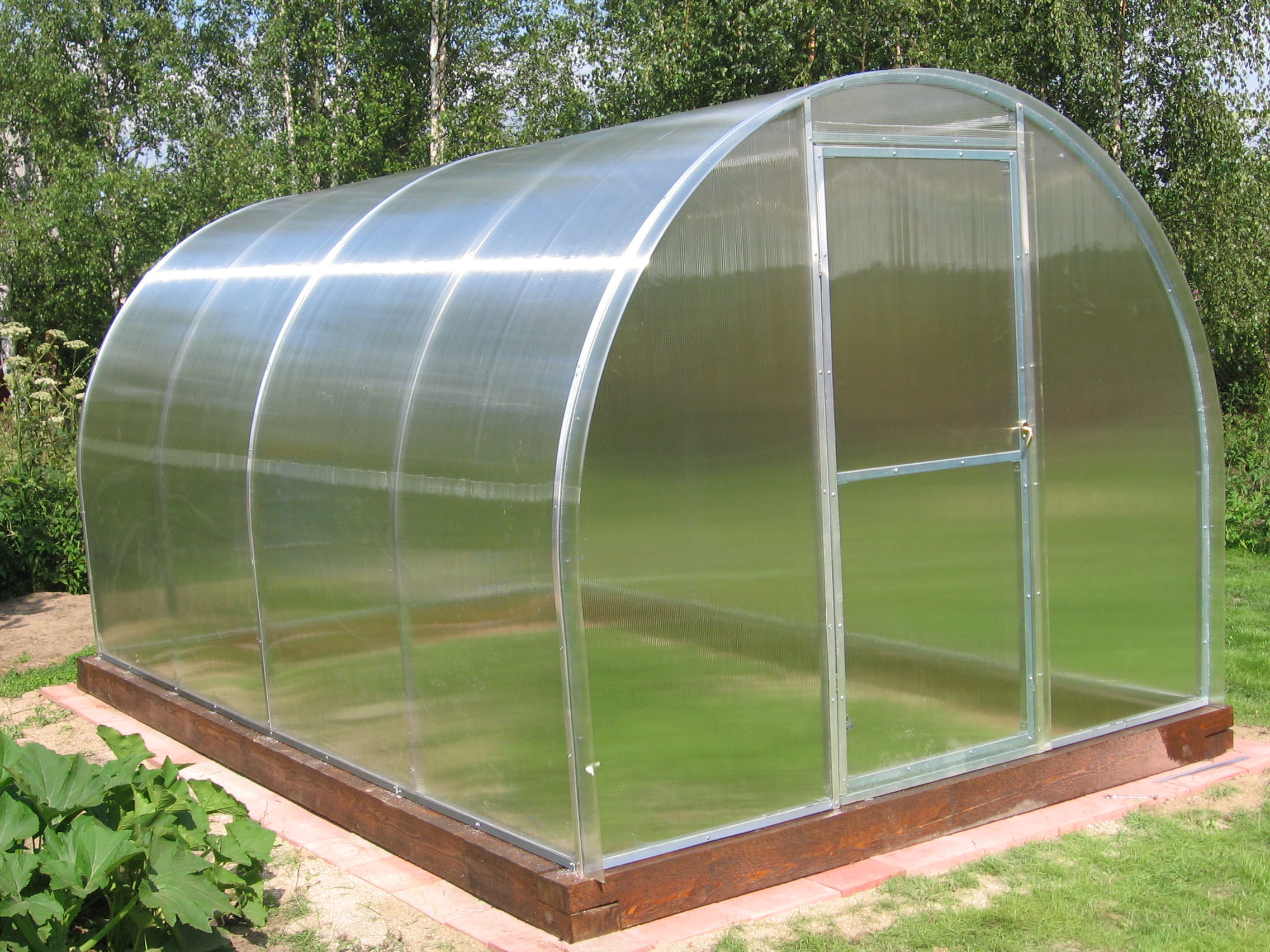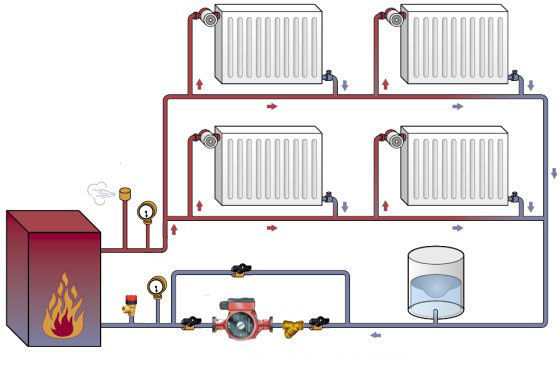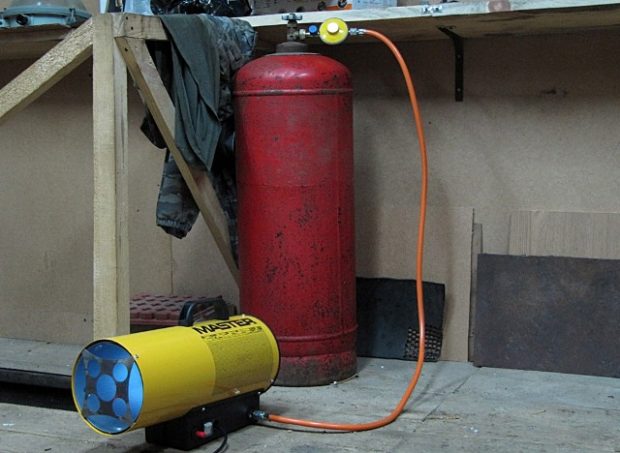Tips for choosing and installing a greenhouse heating system (5 heating options)
Heating the greenhouse and maintaining a comfortable temperature for plantations makes it possible to “live” in it various cultures throughout the year. You can harvest three times a year and surround yourself with beautiful thermophilic Mediterranean tropical plants, organizing the conditions suitable for their cultivation.
Greenhouse heating principles
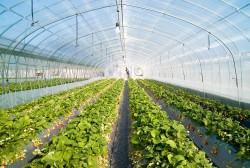 Before creating a greenhouse heating Three main points should be taken into account: area premises type of heating in the home itself and the size future material costs.
Before creating a greenhouse heating Three main points should be taken into account: area premises type of heating in the home itself and the size future material costs.
When organizing heating, it is necessary to take into account the general rules and requirements, the most important of which is the uniform correct dispersion of the warm flow throughout greenhouse areas.
What you need to know before you make heating in a greenhouse?
- so that the stems and leaves of the plants do not fade, indoor air should not be overdried;
- heat transfer should be slow and distributed from top to bottom, and then the heat will remain longer;
- heating system should protect crops from infection pathogenic bacteria and viruses;
- give preference to such types of heating that will save at all stages of investment, mounting and further use;
- control over the heating process should be simple, convenient and easy.
Greenhouse heating methods
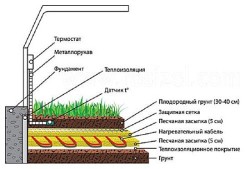 In fact, air heating in a room can occur in two ways - natural or artificial. Natural heating is carried out with the help of sunlight, which passes through the roof covering of the greenhouse, forms a greenhouse effect, and thus, the earth and vegetation are heated. The heating of the greenhouse in the spring occurs in this way. Therefore, due attention must be paid the location of the greenhousewhere the sun will "please" the green residents as much as possible. But you should protect the greenhouse from drafts that will cool the coating.
In fact, air heating in a room can occur in two ways - natural or artificial. Natural heating is carried out with the help of sunlight, which passes through the roof covering of the greenhouse, forms a greenhouse effect, and thus, the earth and vegetation are heated. The heating of the greenhouse in the spring occurs in this way. Therefore, due attention must be paid the location of the greenhousewhere the sun will "please" the green residents as much as possible. But you should protect the greenhouse from drafts that will cool the coating.
For those who want to enjoy vegetables, fruits and beautiful flowers all year round, you will need technical heating installation, which in winter will complement the natural solar heating.
There are many ways to heat a greenhouse in winter. Today, the key types of heating are consideredelectric, solid fuel (furnace), water, air and gas. You can combine different heating methods, highlighting the main type of heating and an additional source.
Greenhouse electric heating
In home small greenhouses, eelectric heating systems. This way to warm the room is the most economical and optimal, while not requiring much effort.
The main advantages of greenhouse heating electrical systems:
 all waste on equipment and supplies will quickly pay off, because Efficiency is quite high;
all waste on equipment and supplies will quickly pay off, because Efficiency is quite high;- during the operation of such a system there are no gases and unwanted vapors, thereby ensuring a clean atmosphere and microclimate;
- independence from human influence, absolute automation;
- safety and durability.
Consider the most popular types of electric heating in a winter greenhouse.
Electric heater in the greenhouse
Electric heater with two main modes of operation, thermostat and a power of 1.1-5 kW. The device is equipped with closed heating elements and for a more efficient circulation of the warm stream has a fan. In industrial greenhouses, heating with an electric air heater is not practical.
Pros of heaters:
 Indoor greenhouses carried out constant air circulation using a fan. This reduces the risk of fungal diseases in growing crops. Thanks to the susceptible thermostat, you can create the microclimate necessary for the vegetation yourself. The electric heater can perform the function of a fan without the participation of heating elements.
Indoor greenhouses carried out constant air circulation using a fan. This reduces the risk of fungal diseases in growing crops. Thanks to the susceptible thermostat, you can create the microclimate necessary for the vegetation yourself. The electric heater can perform the function of a fan without the participation of heating elements.- Affordable cost for the ordinary buyer, automatic operation, ease of operation - these factors further increase the profitability and importance of the device for small greenhouses.
Cons of heaters:
- Than more greenhouse area, the less quality the device copes with the work. For full circulation of heated air, heater must be rearranged from place to place, or purchase additional heating equipment, so waste on electricity are increasing.
- Fragility - Almost all heaters like a heater have to be repaired at the end of the heating season. Again, the cost of farmed products increases.
- The main disadvantage of the device is Do not directly warm the soil. This is one of the reasons that plants do not take root, and their growth slows down. Experienced gardeners also find a way out of this situation - the greenhouse plunges deeper into the soil, and accordingly, the temperature of the soil becomes higher.
- Often in greenhouses, convection heaters and heating systems are used, consisting of pipes that work thanks to boiler with electric heating. They have less efficiencybut they cope with their task.
Infrared ceiling electric heaters in a greenhouse
If a personal "personal" sun appeared in the greenhouse, then you’ve acquired infrared heater. First, the device heats the ground, and then the surrounding air gradually heats up.
Advantages of infrared heaters:
 With low power consumption a large area is heated greenhouses, i.e. This is an energy-efficient way of air heating a greenhouse.
With low power consumption a large area is heated greenhouses, i.e. This is an energy-efficient way of air heating a greenhouse.- Do-it-yourself installation - small size and light weight make it possible to quickly and easily install a heater. IR heaters are also easy to transport.
- Sustainability, reliability and safety - these devices do not dry the air, do not create harmful fumes and unwanted gases, thereby generating natural heat and positively affect the overall development of crops. Operational safety consists in protecting the device from spontaneous combustion, and therefore, the durability of the work is ensured.
- Infrared "sun" famous for automationbuilt-in thermostat, and this helps to save electricity and overheating.
- Durability. High-quality assembly, excellent components and technical specifications will ensure trouble-free operation for several years.
Cons of infrared heaters:
- High price. However, this drawback is twofold. Typically, devices of this type pay off in a few years due to their quality and lean energy consumption.
- The need for additional equipment - in this case, the fan.When the infrared device is working, warm air circulates, which is not enough for natural ventilation.
Electric soil heating (cable heating)
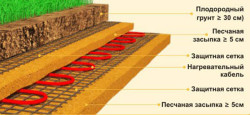 With the rational use of cable heating the land, the owner saves on heating greenhouses and faster harvest. The peculiarity of its action is the laying of special heating wires in the soil, through which an electric current flows using a transformer.
With the rational use of cable heating the land, the owner saves on heating greenhouses and faster harvest. The peculiarity of its action is the laying of special heating wires in the soil, through which an electric current flows using a transformer.
The peculiar systemwarm floor»Is famous for its simplicity in operation, profitability of operation, automatic maintenance of optimal temperature, and uniform distribution of warm air.
To install cable heating, you will need to remove part of the earth, make a layer of sand and lay the wire itself. From above, it is necessary to lay a special heat-insulating material, which will not allow heat to go down, deep into the soil, and protect the cable from excessive moisture and various mechanical damage and loads.
Presented on the market ready sets heating wires with a thermostat, which need a voltage of 220 V. The soil warms up quickly and efficiently, which means that the plants take root well and the crop is harvested earlier.
Furnace heating of the greenhouse (solid fuel heating)
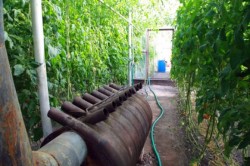 Oven heating method is considered one of the most popular types of heating and is most common in rural areas, where firewood and household waste are in abundance. Solid fuel boiler It operates on coal or wood and is the main device in stove heating.
Oven heating method is considered one of the most popular types of heating and is most common in rural areas, where firewood and household waste are in abundance. Solid fuel boiler It operates on coal or wood and is the main device in stove heating.
The simplest type of such heating includes itself boiler and chimney (chimney) However, to create better and more efficient heating of the air, this heating system can be understaffed with additional equipment - radiatorspipes.
Today, both boilers for a greenhouse on wood and topical boilers for long burning are available. These greenhouse boilers do not require frequent filling with fuel and use it effectively.
The furnace boiler is installed directly in the greenhouse and this can contribute to the drying of the earth and the formation of too dry air, and growing crops are likely to wither. Therefore, installing a solid fuel boiler requires humidification. The easiest way is to place a large container with water.
Stove heating is also considered one of the most affordable.
Greenhouse water heating
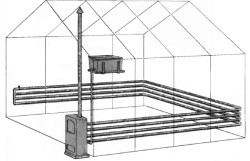 An effective way to heat a greenhouse in winter is water heatingconsidered the most financially profitable, but at the same time, in an outdated, irrelevant way. This heating system of the greenhouse can also be attributed to electric heating.
An effective way to heat a greenhouse in winter is water heatingconsidered the most financially profitable, but at the same time, in an outdated, irrelevant way. This heating system of the greenhouse can also be attributed to electric heating.
Water heating will simultaneously heat both air and soil. Wherein creates an optimal microclimate and soft, not dry air. Such heating requires good ventilation of the room.
In a special boiler water is heated and is sent to the pipes using a circulation pump. The location of the pipes can be different: along the walls of the room or between growing plants.
For water heating, you can use different fuels: firewood, peat, coal, household trash, industrial waste and other species.
Water heating of the greenhouse is considered the most economical, because you can heat everything that burns.
To equip a greenhouse with water heating, you will need to buy:
 Greenhouse boiler or stove. The choice of boiler for heating the greenhouse depends on each individual situation. In areas where there is a gas pipeline, you can purchase gas boiler, which is also considered economical. You can use an electric heating boiler or a boiler designed for solid fuels. Those who want to build heating for the greenhouse with their own hands can do simple - make a brick or metal stove using firewood or coal;
Greenhouse boiler or stove. The choice of boiler for heating the greenhouse depends on each individual situation. In areas where there is a gas pipeline, you can purchase gas boiler, which is also considered economical. You can use an electric heating boiler or a boiler designed for solid fuels. Those who want to build heating for the greenhouse with their own hands can do simple - make a brick or metal stove using firewood or coal;- Radiator. There are aluminum, cast iron, bimetal. There are heating systems and without radiator. In them, the upper part of the greenhouse is heated with the help of large round steel pipes;
- Pipes. They form 2 heating circuits - underground, where plastic pipes with 30-degree water are near the roots of plants. With this warming you will reduce the vegetation process and increase crop yields. And the second circuit - radiators heat the domed air of the structure;
- Chimney. It can be in the form of a metal or asbestos-cement pipe, or it is a traditional brick chimney. Often gardeners use chimneys and expensive sandwich pipes;
- Expansion tank. You can do it yourself from a metal sheet or buy it ready. It is open and closed;
- Circulation pump. Some experts believe that you can do without this element, because water flow will be carried out due to the pressure difference in the entire system (budget greenhouses), therefore, the purchase of a circulation pump depends entirely on the material capabilities of the greenhouse owner.
Greenhouse air heating
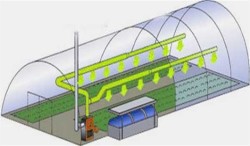 A professional heating system, which is mounted by specialists during the assembly of the mechanism itself. Inside the boiler for heating the greenhouse, air is heated, which, accordingly, “heats” the room.
A professional heating system, which is mounted by specialists during the assembly of the mechanism itself. Inside the boiler for heating the greenhouse, air is heated, which, accordingly, “heats” the room.
The heating and ventilation device is placed on supporting structures, the foundation, or on dedicated supports. The warm stream goes to the top or middle greenhouse or greenhouse. This prevents the burns of plantations and the drying out of leaves and stems. A perforated special hose made of polyethylene is distributed over the area of the greenhouse, ensuring the same heating of the soil.
The most primitive way to implement air heating of the room is one end of the pipe protrudes outside, and the pipe itself is laid in the greenhouse.
It should be noted the advantage of such heating - high heat transfer coefficient at minimum financial cost. It is also not necessary to purchase additional coolants.
Half an hour of work of "air" equipment - and in a greenhouse 20 degrees warmer. Often, steam of various pressures is used to heat the air that is supplied.
Air heating of the greenhouse also includes the use of infrared ceiling electrical units.
Gas heating greenhouses
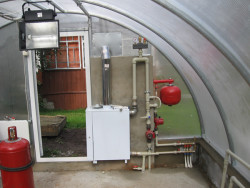 The traditional gas heating of the greenhouse is considered as a “gas-water” heating system - the heating of the heat carrier (water) is carried out in gas boiler.
The traditional gas heating of the greenhouse is considered as a “gas-water” heating system - the heating of the heat carrier (water) is carried out in gas boiler.
Project gas heating systems in the greenhouse must be approved by the gas supply company. Then an order is made, installation and commissioning of gas equipment is also under the supervision of a specialized organization, but not all owners of greenhouses do this. Most often, a separate circuit is distinguished from gas-water heating of a residential building.
Gas heating is divided into:
- A system with one coolant and its distribution in the greenhouse. This includes gas-water heating with additional water heating devices. And gas-air heating with the dispersion of warm air using polyethylene ducts;
- Gas-air heating system with numerous heat sources. Gas convectors and various floor and ceiling heaters (IR, injection, catalyst burners, as well as the use of an open flame) are used.
Gas equipment with open burners in the greenhouse
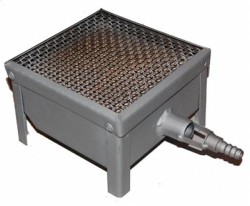 The device consists of open burners, the main and standby, and the thermostat. The source of the resource is a gas cylinder or natural main gas.
The device consists of open burners, the main and standby, and the thermostat. The source of the resource is a gas cylinder or natural main gas.
A temperature comfortable for plants is created in the lower part of the greenhouse - a warm stream tends upward, in contact with the dome of the greenhouse, cools and falls.
The main disadvantage gas space heating - burning oxygen.There must be flow ventilation - a PVC pipe is installed to draw in fresh air.
Greenhouse gas convectors
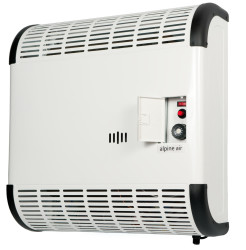 The device consists of sealed combustion chamber (cast iron, steel) with a main burner and closed heat exchanger without a heat carrier, such as water. The gas convector is installed on the wall of the structure.
The device consists of sealed combustion chamber (cast iron, steel) with a main burner and closed heat exchanger without a heat carrier, such as water. The gas convector is installed on the wall of the structure.
Automatically the gas is supplied to the main burner and thereby, the “body” of the heat exchanger is heated from the inside. And then, the whole greenhouse is also heated by natural convection.
The gas convector may be in the form of a coaxial pipe. This design (pipe in pipe) permeates the wall of the greenhouse and evenly draws air and the emission of harmful combustion products into the street - and this saves on ventilation of the greenhouse.
The convector has a built-in thermostat with the function of maintaining the required temperature. Closing the gas valve can be facilitated by interruptions in traction or a shutdown of the gas supply.
Gas convectors can be equipped with electric fans, similar to heaters. In this case, the air in the greenhouse heats up pretty quickly, but the operation of the fan is accompanied by noise and depends on the supply of electricity.
Gas equipment with infrared burners in the greenhouse
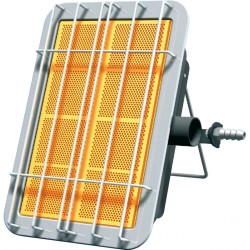 The basis of the heat flux when using infrared burners is considered to be electromagnetic radiation during the heating of their heating elements.
The basis of the heat flux when using infrared burners is considered to be electromagnetic radiation during the heating of their heating elements.
Burners come with heating elements in the form of pipes: the so-called "dark", the maximum heating temperature of which is about 6000C, and “bright” infrared burners with heating elements similar to metal grids, glow temperature over 600 0FROM.
For more efficient heating of the room, several heating systems can be used simultaneously, for example, a set of gas burners that are equally dispersed around the entire perimeter of the greenhouse.
Emergency greenhouse heating
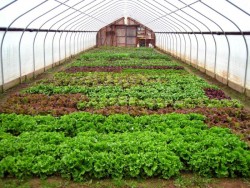 In order to preserve the long-awaited crop in case of unexpected and severe frosts, breakdown of any element of the heating system of the greenhouse, blackout, or other force majeure circumstances, it is necessary own backup heating option.
In order to preserve the long-awaited crop in case of unexpected and severe frosts, breakdown of any element of the heating system of the greenhouse, blackout, or other force majeure circumstances, it is necessary own backup heating option.
In a short period of time, you can quickly organize emergency heating of air in a greenhouse using improvised means. To this endporous bricks doused with gasoline, kerosene (or other flammable liquid) and are placed in an insulated metal tank (container).
With the help of this simple "design" get warm soil well in a greenhouse at night with a sharp drop in temperature. The tank is placed next to the greenhouse, a pipe is removed from it to supply a warm air stream to the upper space of the structure, and a protective curtain-curtain from cold air is formed.
What you need to know for proper thermal insulation of the greenhouse:
 Using double wrap, You will save up to 25% of heat thanks to the air gap between the layers;
Using double wrap, You will save up to 25% of heat thanks to the air gap between the layers;- Thoughtful choice of the location of the greenhouse. Direct sunlight falling on the south side will also contribute to the creation of warm air in the room. And the north side is advisable to be next to the wall of any other structure;
- Take care of additional insulation - with the onset of cold weather or at night, it is recommended outside insulate walls any rags, blankets, mats, etc .;
- When building a greenhouse, you should know that compost layer between the ground and the ground of the greenhouse itself delays heat transfer between the soil of the greenhouse and the soil of the earth;
- Competent choice of heating system for the greenhouse. Must be taken into account climate of the region and the right temperature for a good growth of green spaces;
- In winter, you can take advantage of mirror surfacesreflecting the sun's rays. So you save a lot electricity in the daytime.

